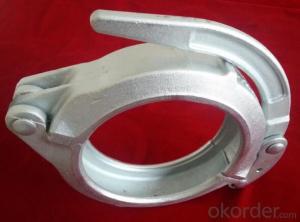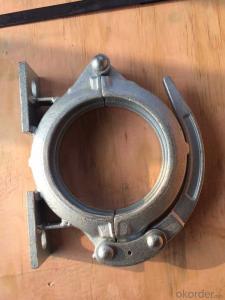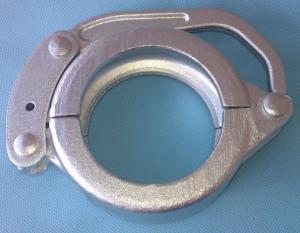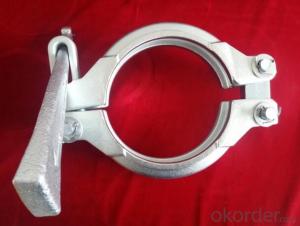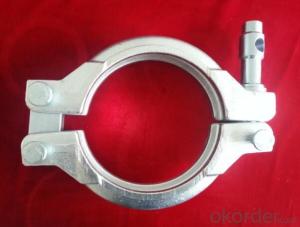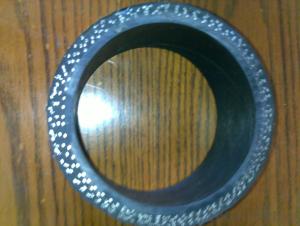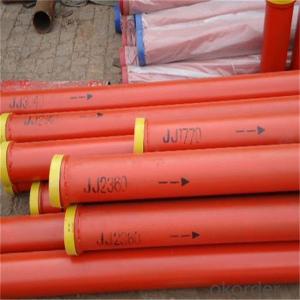Concrete Pump 2bolt Clamp Coupling DN125 Forged
- Loading Port:
- China main port
- Payment Terms:
- TT OR LC
- Min Order Qty:
- 50 PCS
- Supply Capability:
- 10000 PCS/month
OKorder Service Pledge
OKorder Financial Service
You Might Also Like
Product Description:
A coupling is a device used to connect two delivery pieps together at their ends for the purpose of transmitting, and prevent the concrete from leaking. Couplings do not normally allow disconnection of shafts during operation.
Main Product Features:
1. Use high quality steel. After high-temperature 1200 forging,it’s shaped.
2.High temperature forging.
3.convenient to use, easy operation,and high safety.
4.good sealing,wear-resising,longer service life.
5.do not restrict the steering tubes, pipes during the working process can be 360 degrees rotation.
6.used in concrete pump truck,concrete pump and pipeline connection seal in construction
work equipment.
Product Specifications:
1.Forged
2.2--8 inch
3.Galvanizing/Baking varnish
4.More durable,light,beautiful
Production steps:

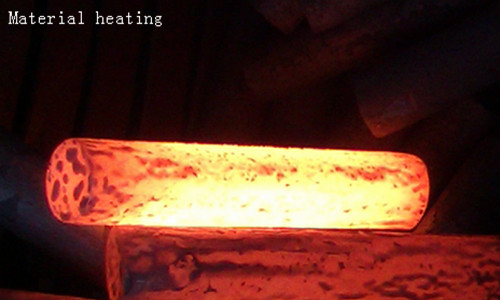
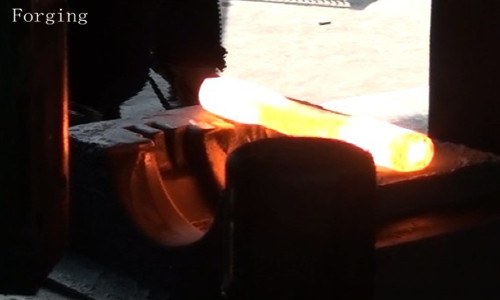

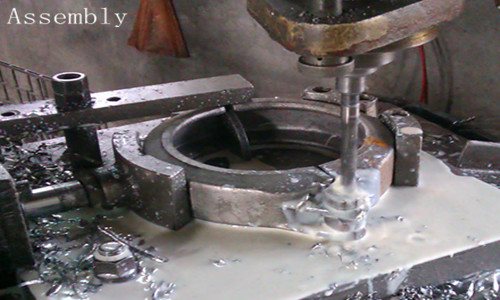



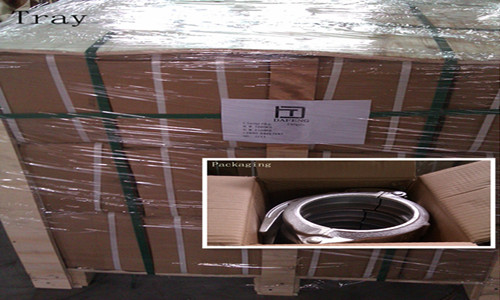
Concrete pump clamp Catalogue
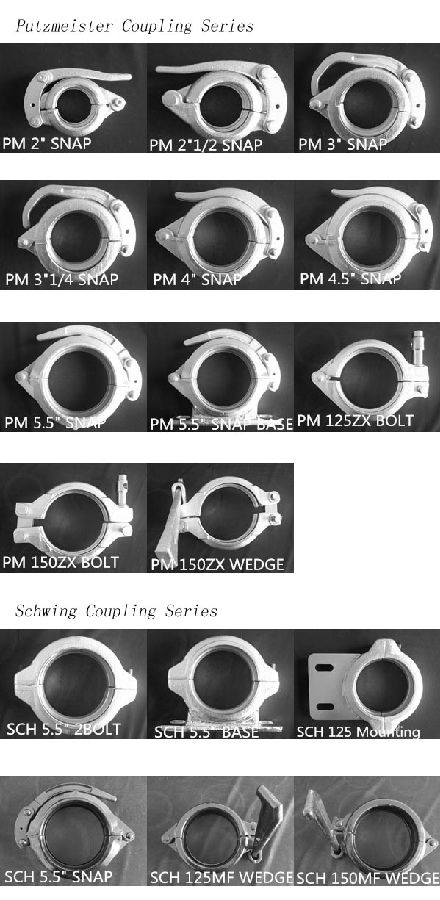

FAQ
1.How do you regarding your product quality?
As our principle is more safety to save more. In China, there are lots of manufactures of this line, but we are the first one that use the forging technic in producing, firmly meet the PM standard.
2.Can I get some samples?
Of course you can. Small sample for free, but you pay the express. For some products are not small, like concrete pump pipe, it’s very difficult to deliver one pipe of 3000mm. If it’s possible, we’d like that you can come here to visit our factory. Welcome!
3. I want to make our logo on the products, is that ok?
Yes, it’s totally ok. OME is available from us.What you should do is send your logo, brand name, or picture to us. And let other things leave on us.
- Q: What are the different types of concrete pump hopper pins?
- There are several types of concrete pump hopper pins, including snap pins, lynch pins, and clevis pins. These pins are used to secure the hopper to the pump and ensure it stays in place during operation.
- Q: How can a faulty water pump affect the concrete pumping operation?
- A faulty water pump can adversely affect the concrete pumping operation in various ways. Firstly, the water pump is responsible for supplying water to the concrete mix, which helps in maintaining the correct consistency and hydration of the concrete. If the water pump is faulty and not functioning properly, it may result in inadequate water supply, leading to an improper mix ratio and compromised quality of the concrete being pumped. Additionally, a faulty water pump may cause interruptions or delays in the pumping process. If the pump fails, it can halt the entire operation until the issue is resolved or a backup pump is brought in. This can result in project delays, increased labor costs, and potential concrete setting issues if the concrete remains stagnant for an extended period. Furthermore, a faulty water pump can also impact the overall efficiency and productivity of the concrete pumping operation. With reduced or inconsistent water supply, the pumping equipment may experience increased wear and tear, resulting in more frequent breakdowns and maintenance requirements. This not only leads to additional costs but also hampers the smooth flow of work. In summary, a faulty water pump can have significant consequences on a concrete pumping operation, affecting the quality of the concrete mix, causing delays, and decreasing overall efficiency. Thus, it is crucial to regularly inspect and maintain water pumps to ensure their proper functioning.
- Q: What are the most commonly replaced spare parts for concrete pumps?
- Concrete pumps commonly require the replacement of certain spare parts. These parts, including wear plates, wear rings, and delivery cylinders, are prone to constant abrasion and wear. This is a result of the high pressures and velocities involved in the movement of concrete. Wear plates, usually made from hardened steel, are installed in high-wear areas such as the hopper to protect against the abrasive nature of concrete. On the other hand, wear rings, made from durable materials like polyurethane, are utilized to minimize friction between the piston and cylinder, thereby reducing wear and maintaining optimal performance. Additionally, delivery cylinders, also known as pumping cylinders, play a crucial role in transferring concrete from the hopper to the discharge outlet. Over time, the interior surface of the cylinder may experience wear or damage, necessitating replacement to ensure efficient concrete flow. Other commonly replaced spare parts include pistons, seals, hydraulic hoses, and couplings. These components, too, undergo wear and tear during the pumping process. It is essential to regularly inspect and maintain these parts to prevent unexpected equipment downtime and ensure the long-term reliability and performance of concrete pumps.
- Q: What are the indications of a faulty concrete pump seal?
- There are several indications that can suggest a faulty concrete pump seal. Some of the common signs include: 1. Leakage: One of the most obvious signs of a faulty seal is leakage. If you notice any leaks around the seal area, it is a clear indication that the seal is not working properly and needs to be replaced. 2. Reduced pumping efficiency: A faulty seal can lead to reduced pumping efficiency. If you notice that the concrete pump is not able to deliver the same amount of concrete as it used to, or if it takes longer to complete a job, it could be due to a faulty seal. 3. Increased noise levels: Another indication of a faulty seal is an increase in noise levels during operation. If you notice any unusual or louder noises coming from the concrete pump, it could be a sign that the seal is not sealing properly and needs to be checked. 4. Vibration or movement: Faulty seals can also lead to excessive vibration or movement in the pump. If you notice that the pump is vibrating more than usual or if it is moving around during operation, it could indicate a problem with the seal. 5. Contamination: A faulty seal can allow contaminants such as dirt, dust, or water to enter the pump. If you notice any signs of contamination in the pump, it is important to inspect the seal and replace it if necessary. It is important to address any indications of a faulty concrete pump seal promptly to avoid further damage to the pump and ensure safe and efficient operation. Regular maintenance and inspection of the seal can help prevent potential issues and extend the life of the concrete pump.
- Q: What are the different types of concrete pump hopper cylinders?
- In the construction industry, there exists a variety of concrete pump hopper cylinders that are commonly utilized. These cylinders possess a vital function in the operation of concrete pumps, as they supply the necessary pressure and force to facilitate the movement of concrete throughout the system. One particular kind of concrete pump hopper cylinder is the single-acting cylinder. This cylinder operates by utilizing hydraulic pressure to extend the piston rod, which subsequently propels the concrete out of the hopper and into the pumping system. Single-acting cylinders are renowned for their simplicity and reliability, thus making them a favored choice for numerous construction projects. Another type of concrete pump hopper cylinder is the double-acting cylinder. As the name implies, this cylinder operates in both directions, enabling a more efficient and powerful pumping process. Double-acting cylinders possess the capability of pushing the concrete out of the hopper during the extension stroke, as well as pulling the piston rod back during the retraction stroke. Consequently, this results in a greater pumping capacity and increased productivity. Furthermore, there is also a range of sizes and capacities available for concrete pump hopper cylinders. These sizes vary, with smaller cylinders suitable for smaller construction projects, and larger cylinders capable of handling heavy-duty pumping operations. The selection of cylinder size relies on factors such as the volume of concrete to be pumped, the distance and height of the pumping location, and the specific requirements of the project. In conclusion, the assortment of concrete pump hopper cylinders encompasses single-acting cylinders and double-acting cylinders. Each type possesses its own advantages and is suitable for different construction applications. The determination of the cylinder's size and capacity should be based on the specific necessities of the project. Ultimately, the selection of the appropriate cylinder type is essential in guaranteeing efficient and effective concrete pumping operations.
- Q: How often should concrete pump control levers be inspected and replaced?
- Regular inspections should be conducted on concrete pump control levers to ensure they are in proper working order. The frequency of these inspections and any necessary replacements will depend on various factors, such as usage levels, environmental conditions, and the quality of equipment maintenance. As a general rule, it is recommended to inspect the control levers at least once a year. This inspection should involve a thorough examination of the lever mechanism to check for any signs of wear, damage, or malfunction. It is also advisable to inspect the levers after any major repairs or maintenance to ensure they have been correctly reinstalled and are functioning properly. If any issues are identified during the inspection, it is crucial to address them promptly. Depending on the severity of the problem, repairs or replacements may be required. Minor repairs can often be carried out on-site, while more significant issues may necessitate the assistance of a professional technician. Regular maintenance, including lubrication and cleaning, is important for extending the lifespan of the control levers. Following the manufacturer's maintenance and usage guidelines can also help prevent premature wear and damage. Ultimately, the frequency of inspections and replacements may vary based on specific circumstances. It is advisable to consult the equipment's manual or the manufacturer for precise recommendations regarding the maintenance and replacement of the control levers.
- Q: How does the concrete pump work?
- When the pump is in place, support the leg and keep the body level and stable. When feeding with a distributor, the body shall not exceed 3 degrees of inclination
- Q: How to judge the concrete pipeline blockage?
- When the conveying pressure increases gradually, while the material level of the hopper does not fall, the pipe outlet is not out of stock, the pump vibrates, and the pipe is accompanied by strong vibration and displacement, the pipe blockage can be determined.
- Q: What are the signs of a faulty concrete pump control panel?
- There are several signs that can indicate a faulty concrete pump control panel. Firstly, if the control panel is not powering on or experiencing intermittent power loss, it could be a sign of a faulty electrical connection or a malfunctioning power supply. This can prevent the panel from functioning properly and controlling the concrete pump. Secondly, if the control panel is displaying error messages or error codes, it suggests that there may be an issue with the internal components or sensors. These errors can range from minor malfunctions to more serious problems that require immediate attention. Additionally, a faulty control panel may exhibit erratic behavior or unresponsive controls. For example, if the buttons or switches do not respond when pressed, or if they behave inconsistently, it could indicate a problem with the panel's circuitry or wiring. Moreover, unusual noises or vibrations coming from the control panel can be a sign of internal mechanical issues. These could include loose or damaged components, faulty relays, or malfunctioning motors. Lastly, if the concrete pump is not operating as expected, it could be due to a faulty control panel. Inadequate pressure, incorrect flow rates, or difficulty in starting or stopping the pump may all be indicators of a control panel malfunction. In any case, if you suspect that the control panel of a concrete pump is faulty, it is important to consult a professional technician or manufacturer for inspection, diagnosis, and repair.
- Q: How can a faulty outrigger affect the stability of the pump?
- The stability of a pump can be significantly affected by a faulty outrigger. The outrigger serves as a crucial component that provides support and balance to the pump while it is in operation. Its role is to act as a stabilizer, preventing the pump from tipping over or vibrating excessively. When the outrigger is faulty, it fails to offer the necessary support and stability required for the pump to function properly. This can result in various stability issues. For instance, the pump becomes more susceptible to tipping over, particularly when it encounters uneven surfaces or strong vibrations. This poses a significant danger, especially if the pump is handling hazardous or flammable materials. Moreover, a faulty outrigger can cause excessive vibrations in the pump. These vibrations can accelerate the wear and tear of critical components, leading to premature failure. Additionally, they can inflict damage on the surrounding infrastructure or equipment, resulting in expensive repairs or even accidents. Furthermore, a faulty outrigger can impact the accuracy and efficiency of the pump's operation. When the pump is not adequately stabilized, it struggles to maintain a consistent flow rate or pressure, thereby affecting its overall performance. This can lead to inefficiencies, increased energy consumption, and even reduced productivity. To summarize, a faulty outrigger has detrimental consequences for the stability of a pump. It heightens the risk of accidents, induces excessive vibrations, and impairs the pump's performance and efficiency. Regular maintenance and inspections are crucial in ensuring that the outrigger and other support systems are functioning correctly, thereby maintaining the pump's stability and reliability.
Send your message to us
Concrete Pump 2bolt Clamp Coupling DN125 Forged
- Loading Port:
- China main port
- Payment Terms:
- TT OR LC
- Min Order Qty:
- 50 PCS
- Supply Capability:
- 10000 PCS/month
OKorder Service Pledge
OKorder Financial Service
Similar products
Hot products
Hot Searches
Related keywords














